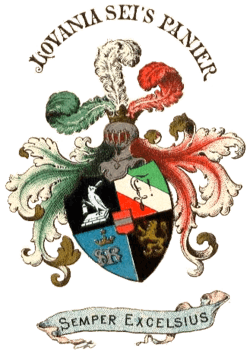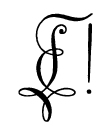K.A.V. Lovania Leuven
Katholische Academische Verbinding (K.A.V.) Lovania Leuven is a Catholic academic fraternity, founded in 1896 at the Katholieke Universiteit Leuven, Leuven, Belgium. It is a German Studentenverbindung and is an affiliated member of the Cartellverband der katholischen deutschen Studentenverbindungen. Her motto is Semper Excelsius! (Der Geist lebt in uns allen!). Its official coulours (Couleur) are green, white and red.
History

The Catholic university of Louvain, founded in 1425, was closed down during the occupation of the Low Countries in 1797 after the French revolutionaries occupied the country. After the defeat of the revolutionaries the university was refounded in 1834 and was able to attract quite a number of Catholic students from Germany, Austria and Switzerland who were fleeing the Kulturkampf.
At first a Swiss Catholic student fraternity was founded, Helvetia Lovaniensis. It existed from 1872 to 1875. It was succeeded by an all German Catholic student fraternity, Tungria Lovaniensis, that existed from 1877 until 1879. In 1888 a regional student fraternity was founded by students from Luxemburg. Only the last fraternity survived. Out of the ashes of the demise of the Swiss and German fraternities, a new fraternity was founded.
This event was triggered by a public allocution of Armand Thiéry, a professor in thomistic philosophy at the university, on student life at Germanic universities on January 21, 1896. During his student years in Bonn, Thiéry had become a member of the prestigious student fraternity K.D.St. V. Bavaria Bonn, the oldest Catholic student fraternity in the world. This speech motivated a number of Germanic students to such an extent that they decided to establish a fraternity that same evening. It was called Lovania, which is Latin for Leuven (Louvain). The fraternity quickly expanded and Prof. Thiéry became honorary president. Lovania continued to blossom until the outbreak of the First World War. In 1914 the fraternity was suspended due to the commencement of fighting. At that moment the fraternity already had more than 160 active and inactive members. Numerous members died on both sides of the war.
In post war Belgium it was impossible to re-establish a German student fraternity in 1918. Promising efforts were made during 1927 and 1928 but failed after a short period of time. The Second World War made a quick re-establishment even more impossible. It took until 1996 until the political situation was stable enough to reconstitute the fraternity. At that moment many students who belonged to fraternities were members of the Cartellverband and studied in Louvain. The idea then arose to re-establish the fraternity. The last surviving member gave his blessing to this undertaking and on April 19, 1996 the reactivation became a reality. In 1999 the friendly affiliation to the Cartellverband was formally re-established. Today the fraternity flourishes and has 97 members to date, originating from Flanders, the Netherlands, Germany, Austria, Switzerland, Poland, the United Kingdom, Ireland and the United States.
Principles

Lovania is founded upon three guiding principles:
- religio: the fraternity and all its members publicly adhere to the Roman Catholic faith
- scientia: the pursuit of an academic education of all of its members
- amicitia: a lifelong friendship between all the members of the fraternity as long as they live whilst demonstrating a strong esprit de corps
The members of Lovania do not practice academic fencing (Mensur) because it is forbidden by the Roman Catholic Church. Academic fencing is common with the more secular student fraternities that already existed in Germanic countries. Due to this restriction, Catholic students had to organize themselves in separate fraternities. Lovania only accepts men into the organization.
Structures
The fraternity has a legislative (the power to make laws), executive (the power to implement laws) and judiciary (the power to judge and apply punishment when laws are broken) body. All full members make up the legislative body, which elects the executive body. The legislative body also functions as a judiciary body. In this case it assumes the function of an honorary senate.
Traditions

The official dress symbols, that are worn by each member, consist of a vertical green-white-red triband bordered with a golden thread and a green kepi, the historical military cap as worn during the American Civil War.
During official ceremonies and special occasions, the praesidium wears a dress uniform, a traditional Polish military uniform called a Vollwichs which consists mainly of a bekiesza.
Famous members (selection)
deceased
- Prof. Dr. Prosper Viscount Poullet (December 9, 1871 - December 23, 1935) former prime minister of Belgium and Minister of State
- Pierre Prüm (July 9, 1886 – February 1 1950) former prime minister of Luxemburg
- Alexander Count von Kolowrat (January 29, 1886 – December 4, 1927) founder of the Austrian movie industry
- Mon De Goeyse (October 1, 1907 - December 21, 1998), Flemish student leader, author of the clubcodex
- Prof. Dr. Albert Carnoy (November 7, 1878 - January 12, 1961), Belgian minister of internal affairs and health
- Mgr. Charles Cartuyvels (February 27, 1835), vice-rector of the Catholic University of Louvain
- Mr. Georges Baron Holvoet (August 16, 1874 - April 23, 1964), governor of the (Belgian) province of Antwerpen and chef de cabinet of the Prince-regent Charles of Belgium
- Paul Lebeau (June 29, 1908 - October 18, 1982) Flemish author
- Prof. Dr. Albert Michotte (1881 - 1965), experimental psychologist
- Etienne Baron Orban de Xivry (February 18, 1885 - July 23, 1953), Belgische senator
- Jef van den Eynde (December 21, 1879 - April 12, 1929), Flemish student leader
- Prof. Dr. Adam van Kan (July 18, 1877 - June 6, 1944), Dutch scientist
- Prof. Dr. Dr. Dr. Ir Can. Armand Thiéry (6. augustus 1868 - 12. januari 1955), priest and founder of the fraternity
- Mr. Charles Baron Woeste (February 26, 1837 - April 5, 1922), Belgian Minister of State
Literature
- Wehr, Florian, Geschichte des CV, 2. Auflage, Berlin, 1900
- Thiéry Armand, Chansonnier des étudiants Belges publié par la Studentenverbindung Lovania, Breitkopf et Härtel, Brüssel, 1901
- Lovania - 10 Jahre deutschsprechenden Studententums in Löwen 1895-1905, Leuven, 1906
- 15. Vereinsjahr - Academische Studenten Verbindung Lovania 1895-1910, Leuven, 1910
- Wils J., Les étudiants des régions comprises dans la Nation germanique de l'Université de Louvain, 2, Leuven, 1910
- Katholische Academische Studentenverbindung Lovania - Jahresbericht 1910-1912, Druck. F. Giele, Leuven, 1912
- Wolf Otto, Geschichte der katholischen deutschen Studentenverbindung Bavaria 1844-1914, Bonn, 1914
- Contzen Hans, Lovania - Zwanzig Jahre deutschsprechenden Studententums in Belgien, Studentenbibliothek 24), Mönchengladbach, 1916
- Schulze, Friedrich, Ssymank, Paul, Das deutsche Studententum von den ältesten Zeiten bis zur Gegenwart, 1932, Verlag für Hochschulkunde, München (Nachdruck), ISBN 3-923621-90-6
- Doergé Robert., 75 Jahre katholische deutsche Studentenverbindung Franconia an der Rheinisch-Westfälischen technischen Hochschule Aachen 1898-1973, Aachen, 1974
- de Bruyne, Arthur (Ed.), Bijdragen tot de geschiedenis van een generatie - Een liber amicorum voor mr. Willem Melis, Rinda, 1977, Kemzeke
- de Goeyse Mon., O Vrij-Studentenheerlijkheid, Leuvense Universitaire Pers, Leuven, 1987, ISBN 90-6186-251-5
- Schieweck-Mauk S., Lexikon der CV- und ÖCV-Verbindungen, Gemeinschaft für deutsche Studentengeschichte, Würzburg, 1997, ISBN 3-89498-040-0
- Bodman, Ernst-Michael, 100 Jahre K.D.St.-V. Franconia Aachen, Aachen, 1999
- Uytterhoeven R., Nostalgia Lovaniensis, Universitaire Pers Leuven, Leuven, 2000, ISBN 90-5867-065-1
- Vos Louis, Weets Wilfried, (Ed.), Vlaamse vaandels, rode petten, Uitgeverij Pelckmans, Kapellen, 2002, ISBN 90-289-3204-6
- Hartmann, Gerhard, Für Gott und Vaterland - Geschichte und Wirken des CV in Österreich, Lahn-Verlag, Wien, 2006, ISBN 3-7840-3362-8
- Huys, Jan, Van de Weyer Stefan, De studentikoze erfenis van Rodenbach, Acco Drukkerij, Leuven, 2006
External links
- Website of K.A.V. Lovania Leuven
- Historical postcards of K.A.V. Lovania zu Löwen
- Cartellverband der katholischen deutschen Studentenverbindungen